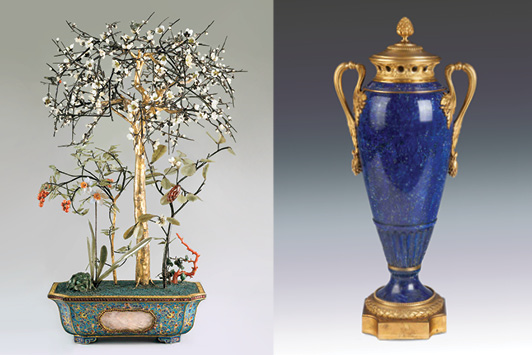
Known for her jewelry and gems as well as European and Russian art, cereal heiress Marjorie Merriweather Post also assembled a large collection of hard-stone decorative objects. They are currently on display in a new exhibition, “Natural Beauties: Exquisite Works of Minerals and Gems,” at Hillwood, her former estate-turned-museum in northwest Washington, DC.
“She had a specific taste for certain materials and techniques, including stones,” says Hillwood chief curator Wilfried Zeisler. “She began to collect objects made of hard stone during late 1910 and the early 1920s, from different origins. The exhibition allows us to showcase this different aspect of the collection.”
Almost 150 items are on view, including “pieces that had been in storage since they were acquired and are now being shown to the public for the first time, and a few loans to show the richness and diversity of this category,” Zeisler says.
Telling a global story
To begin, visitors are introduced to hard stones, which have been subjects of fascination all over the world and can be transformed into extraordinary objects “when enhanced by the skills of artisans,” Zeisler says. Display cases focusing on a specific type of stone also include the stone in its natural state.
The exhibit spans the 17th century through today, with objects from France, Austria, England, Italy, China and Russia. “There are display cases grouped by location, culture and type of stones, such as marble, jade, lapis lazuli, agate and bloodstone, the birthstone for March, which is the month Post was born. She collected many examples of it,” says Zeisler.
Sometimes the stones are just polished and mounted in gold or silver, he continues. “Sometimes they are carved or engraved, or feature cameos and inlaid work. Some objects are also set with diamonds and precious gems.”
The majority are small objects like snuff and presentation boxes and desk seals. The latter, especially from Russia, may feature rock crystal, rhodonite or nephrite.
From Russia, with artistry
A large part of the exhibition is dedicated to Russia, starting with an early 20th-century Fabergé clock from a private collector. Set atop a marble pedestal, it features cabochon sapphires from the Ural Mountains. Russia produced many objects of hard stone thanks to natural resources in those mountains. Rhodonite, malachite, rock crystal and smoky quartz from the mines became accessories and decorative objects — made locally, exported to Moscow and St. Petersburg for famous jewelers to use, and then exported worldwide from there.
Among the items in this section is a case of smaller objects by Fabergé, including rarely seen miniature Russian folk figurines made of semiprecious stones.
In 1830s Russia, malachite was very fashionable. Products made from it were introduced in the Great Exhibition of London in 1851 by the Demidoff family, who owned mines in the Ural Mountains and founded a malachite factory, according to Zeisler. Post favored the green malachite, he notes, and had a large collection of mid-19th to early 20th-century objects. Three of these tables, two candelabras, several vases, a clock and other items are shown all together in what Zeisler calls a “wow” moment.
Two spinel pieces on display represent heirlooms of the Yusupov family, who were Russian nobles. One piece, a Buddha, is believed to come from the collection of a Chinese emperor and now belongs to a private collector. The other is a small box with a spinel lion, which Post bought. Prince Felix Yusupov saved the pieces during the Russian Revolution and sold them after he emigrated. The two objects have not been shown together since the 1920s.
Modern luxuries
The last part of the show highlights Post’s taste for luxuries containing semiprecious stones, many of which feature modern designs like Art Deco. Examples include some of her Cartier frames, agate ashtrays, and objects made of lapis lazuli. There’s also a table Post commissioned in the 1920s for her former Florida estate, Mar-a-Lago, notes Zeisler. “Made with Florentine marquetry, an inlaid work of semiprecious stones and marble, it has several leaves, and we will use one in the exhibition space.”
A contemporary piece by sculptor Barry X Ball, titled Envy, ends the show and highlights the continued inspiration artists find in hard stones. “Ball is known for scanning historic sculptures and carving the 3D scans, finishing them by hand with his team in different stones,” says Zeisler. “It is an interesting mix of contemporary art and semiprecious stones and marble.”
The exhibition, he adds, is less about gemology and “more about how these materials were used to form decorative objects. You can travel the world following the path of these stones, from mine to workshop, and discover that each culture may have different ways of using these stones, but they have always appreciated and collected them.”
“Natural Beauties: Exquisite Works of Minerals and Gems” will be at the Hillwood Estate, Museum, and Garden in Washington, DC, through June 7. hillwoodmuseum.org
Images: Hillwood Estate, Museum & Gardens; Brian Searby/Hillwood Estate, Museum & GardensArticle from the Rapaport Magazine - March 2020. To subscribe click here.